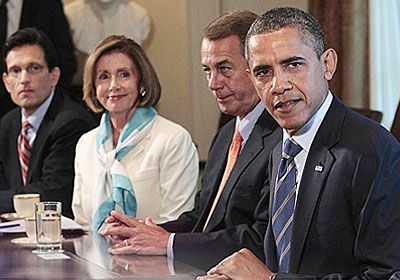Ratings Agencies Want to See Bush Tax Cuts Lapse
The suggestion that the US needs to cut $4 trillion in projected debt over the next ten years in order to avoid a downgrade in its debt rating, posed here in an S&P report, has gained significant traction among many on the right. Erick Erickson, when he's not denying "absolution" to the falsely faithful in the GOP, has emphasized this cut of $4 trillion as crucial to avoid a downgrade.
However, digging into the S&P report reveals some details that might be more problematic for many seeming "deficit hawks." Though this report does suggest that $4 trillion in cuts/increased revenue over the next ten years would be enough to keep an AAA rating, it also says that its baseline for savings assumes the expiration of the Bush tax cuts in 2012. Will many of these "deficit hawks" abandon those tax cuts in order to appease S&P and keep an AAA rating?
This report also makes an interesting---and perhaps unwarranted---logical jump:
Congress and the Administration might also settle for a smaller increase in the debt ceiling, or they might agree on a plan that, while avoiding a near-term default, might not, in our view, materially improve our base case expectation for the future path of the net general government debt-to-GDP ratio. U.S. political debate is currently more focused on the need for medium-term fiscal consolidation than it has been for a decade. Based on this, we believe that an inability to reach an agreement now could indicate that an agreement will not be reached for several more years. We view an inability to timely agree and credibly implement medium-term fiscal consolidation policy as inconsistent with a ‘AAA’ sovereign rating, given the expected government debt trajectory noted above.
Really? Right now, we have had a House filled with new members who have a radical antipathy to the sitting president, his party (which controls the Senate), and (Democratic) deficit spending. I would think now might be one of the times when a long-term agreement was least likely. Things could be radically different 2 years from now. If Obama wins reelection, the Republican majority in the House would likely be quite diminished, if not destroyed. Meanwhile, the Senate, a more consent-run institution, would likely have a narrow Democratic or Republican majority. Wouldn't that situation be more likely to have a bipartisan agreement? Likewise, a Republican victory in November 2012 could very likely lead to Republicans controlling both houses of Congress and the presidency. Surely that scenario would also be likely to pass a long-term debt-decreasing strategy---or at least more likely than the present. S&P might be guilty here of setting a false deadline. This is not the first time S&P has made mistakes in its analysis.
Moreover, it's worth noting that S&P does seem not overly concerned about the current amount of US debt as a percentage of GDP. After all, many countries (such as Germany and France) have debts that are greater fractions of their economies than the USA does by many estimates (S&P currently estimates that the US debt-to-GDP ratio is close to 75%). Moreover, US bonds constitute nearly 60% of AAA-traded government bonds. And interest rates on long-term government bonds are very low, indicating that investors feel quite safe buying US treasuries. Much of the market seems to believe that US debt is a safe investment.
What S&P is concerned about---and we should be concerned with---is the trajectory of debt as a percentage of GDP, which has shot upwards in recent years. One of the biggest drivers of our debt problems in the short term is the poor economy (Medicare is one of the biggest in the long term). And S&P warns that refusing to raise the debt ceiling could lead to a worsening of the economy and further degrade the US debt outlook. This S&P analysis suggests that raising the debt ceiling without $4 trillion in savings and the repeal of the Bush tax cuts might lead to a downgrade (nowhere does it say that it will downgrade US debt if cuts are less than $4 trillion), but refusing to raise the debt ceiling would very likely lead to a downgrade.
The miserable employment picture and resulting diminished tax revenues probably accounts for at least half (and perhaps much more) of the current deficit---over $700 billion dollars a year. Getting back to a fully functioning economy would shave trillions off the debt over the next decade. Anything that gets in the way of a real economic recovery would likely worsen, not resolve, our debt crisis.


